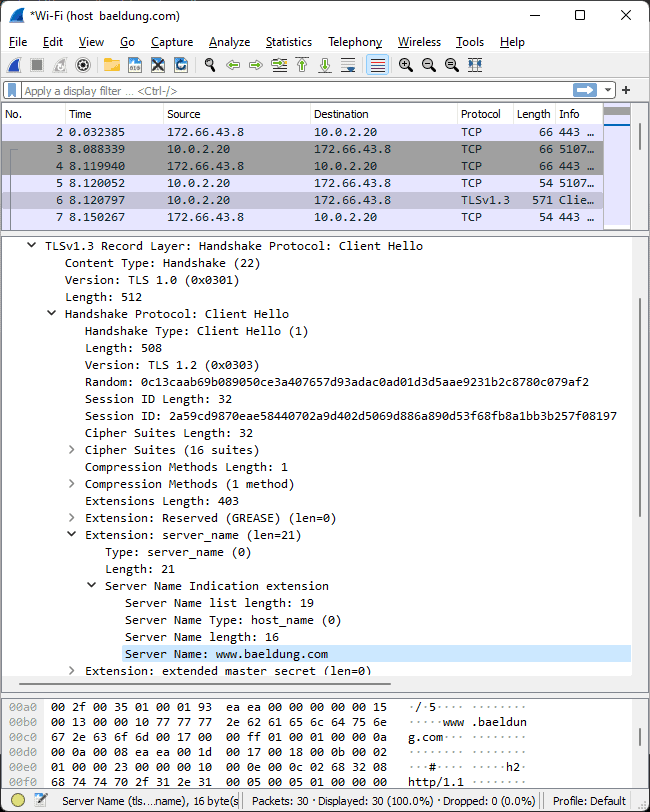1. 简介
在日常使用网络服务时,我们习惯性地会在地址栏查看是否出现“锁”图标。这个图标表示当前连接使用了 HTTPS,代表该网站具备一定级别的安全性。
HTTPS 被广泛认为是一种安全的通信方式,但 HTTPS 传输过程中,到底哪些信息是真正加密的?是否存在某些数据可能被窃听?特别是,HTTPS 的 URL 是否会被加密?
本文将围绕这些问题展开讨论。
我们都知道,数字安全和隐私保护的历史几乎与互联网本身一样久远。在 WWW 早期,像 FTP、Telnet、SMTP 等协议一样,HTTP 协议也采用明文传输的方式,这意味着通信路径上的任何中间人都可以截取并读取所有数据。
为了增强安全性,HTTP 协议后来引入了加密机制,即我们熟知的 HTTPS,最初使用 SSL,现在主要使用 TLS。
2. 为什么需要加密?
✅ 加密(Encryption)是指通过某种方式对信息进行编码,使得只有通信双方能够理解其内容。它在信息安全中扮演着至关重要的角色,主要实现以下几个目标:
- 机密性(Confidentiality):防止信息被未经授权的第三方获取
- 完整性(Integrity):确保信息在传输过程中未被篡改
- 可用性(Availability):确保信息在需要时可被访问
- 不可否认性(Non-repudiation):防止发送方否认其发送行为
- 身份验证(Authentication):确认通信双方的身份
- 授权(Authorization):确保只有授权用户才能访问资源
现代加密技术依赖于密钥机制,只有通信两端持有正确的密钥才能解密或修改数据。通过增加密钥长度或使用更强的加密算法,可以进一步提升通信安全性。
本文不会深入探讨加密技术细节,相关内容可参考我们之前的文章:对称加密 vs 非对称加密、RSA 加密、AES 加密。
3. HTTPS 的工作原理
HTTPS 的核心在于将加密机制引入 HTTP 协议中,使得通信双方可以进行身份认证和数据加密。通常,HTTPS 会使用证书对服务器进行认证,也可以对客户端进行认证(即双向认证)。
先来回顾一下 HTTPS URL 的结构:
https://[user:password/@<hostname.domain_name>/<resouce_path>[/resource_name][?parameter_1¶meter_2&...]
其中:
user、password、resouce_path、parameter等为可选参数hostname.domain_name用于构建 Server Name Indicator(SNI)
此外,参数也可以通过 HTTP 请求体或头部发送,例如:
POST /test HTTP/1.1
Host: www.example.com
Content-Type: application/x-www-form-urlencoded
Content-Length: 27
field1=value1&field2=value2
了解这些结构有助于我们判断哪些部分可能未被加密。
一个典型的 HTTPS 通信流程如下图所示:
其中:
- 客户端发起 DNS 查询,将域名解析为 IP 地址(DNS 查询本身未加密)
- 客户端与服务器建立 TCP 连接
- 客户端发送
ClientHello消息,其中包含请求的 Server Name(SNI) - 服务器响应
ServerHello,开始 TLS 握手 - 双方协商加密密钥
- 后续所有数据(包括 URL、参数、请求体等)均被加密传输
以访问 Baeldung logo 为例,在 Wireshark 抓包工具中可以看到 SNI 是以明文形式发送的:

⚠️ 注意:SNI 是唯一在 TLS 握手阶段明文传输的部分。握手完成后,所有通信内容(包括完整的 URL 和参数)都处于加密状态。
4. HTTPS URL 是否加密?
✅ 结论:HTTPS 的完整 URL 是加密的。包括路径、参数等应用层数据都在 TLS 握手完成后被加密传输。
❌ 但 Server Name Indicator(SNI)部分是明文传输的。SNI 是从 URL 中提取的主机名和域名部分,用于服务器识别虚拟主机并选择正确的证书。
TLS 1.3 标准中提出了加密 SNI 的方案(Encrypted SNI),但目前尚未被广泛支持。主流浏览器如 Chrome(当前版本为 95.0.4638.69)仍使用明文 SNI。
你可以通过 Cloudflare 浏览器安全检查页面 查看你的浏览器是否支持 E-SNI、加密 DNS 查询(DoH/DoT)等安全特性。
5. 代理服务器的影响
代理服务器作为通信路径中的“中间人”,可以用于缓存、安全策略控制、内容过滤等用途。根据配置方式,可分为:
- 显式代理:用户手动配置代理服务器
- 透明代理:由网络设备自动配置,用户无感知
5.1 透明代理的潜在风险
- 可通过
CONNECT请求获取目标服务器的域名 - 更严重的是,代理可以伪造服务器证书,实施中间人攻击(MITM)
在这种情况下,如果客户端信任了代理的根证书(例如企业网络中通过组策略部署),浏览器不会提示证书错误。
5.2 如何识别 MITM?
可以通过查看网站证书的签发机构(CA)来判断:
- ✅ 正常情况下:由知名 CA(如 Let's Encrypt、DigiCert)签发
- ⚠️ 异常情况:由公司或国家控制的 CA 签发
6. 总结
✅ HTTPS 确保了除 SNI 以外的整个 URL 和通信内容的加密传输。
❌ 但以下信息仍可能被中间人获取:
- DNS 查询(明文)
- TLS 握手阶段的 Server Name(SNI,明文)
- 若拥有服务器私钥,可解密整个通信内容
此外,代理服务器或 MITM 攻击者若能插入证书链,也可能实现对 HTTPS 流量的完整解密。
因此,尽管 HTTPS 提供了强大的安全保障,但并不能做到“绝对隐私”。在敏感场景中,还需结合其他安全机制(如 DoH、E-SNI、双向认证)共同防护。